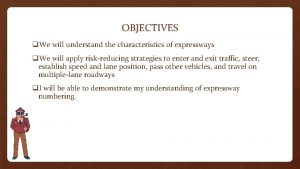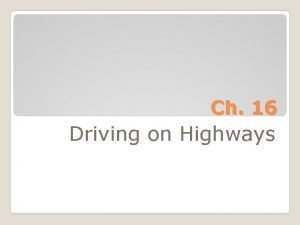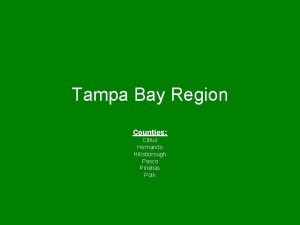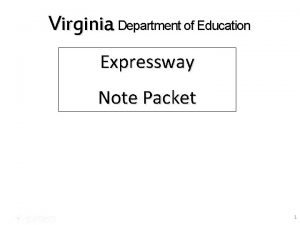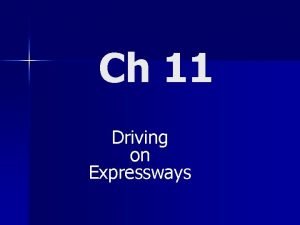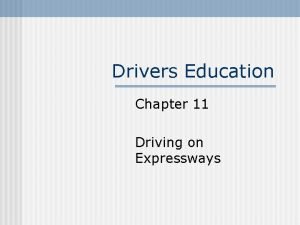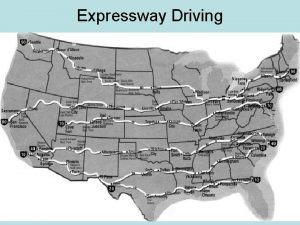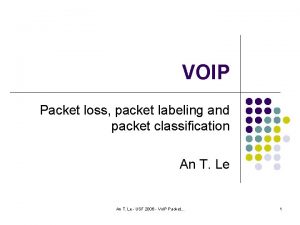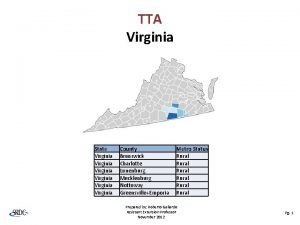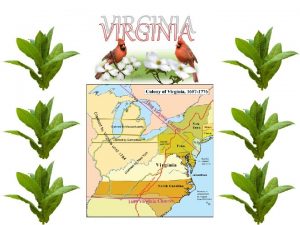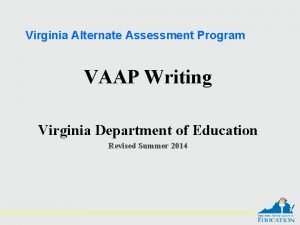Virginia Department of Education Expressway Note Packet 1

















- Slides: 17

Virginia Department of Education Expressway Note Packet 1

Entrance Ramp The entrance ramp allows drivers to enter the ramp and begin searching for a gap/open space Accelerate to speed of traffic Determine the open space and merge safely Entrance Ramp

Entrance Ramp Problems Heavy traffic, short ramps and acceleration lanes High walls that may block visibility Traffic ahead on the ramp that slows or stops abruptly Sharp curves on the ramp that restrict visibility On-Ramp

Entering the Expressway 3 Parts of the Entrance Ramp 1. Entrance 2. Acceleration lane 3. Merge area 1. Entrance 3. Merge Area 2. Acceleration Lane

Acceleration Lane Used to accelerate to blend with the speed of traffic on the expressway Acceleration Lane Good Habits Using the Acceleration Lane Maintain speed/acceleration Signal In the acceleration lane accelerate to the speed of vehicles on the limited access road Continue to check front and rear zones, mirrors and blind spot Decide when and where to merge

Merge Lane The merge area provides a designated space to blend into expressway traffic . Merge Area

Merging—Selecting a Gap Check Front Zone Check Rear and Left Rear Zones Select Gap Identify a Target Area in the Open Space and Merge Merging Problems Heavy traffic Lack of a gap Traffic slowing or stopping ahead Merging Could adjust speed or change lanes ***When a driver is attempting to merge onto the expressway, help them by adjusting speed or changing lanes if it is safe to do so

Ramp Meters Entrance ramp traffic lights are designed to distribute traffic onto the expressway when traffic is heavy Permits one car at a time to enter the expressway Entrance Ramp Mistakes If you ever enter a ramp area and see it marked with “DO NOT ENTER” and/or “WRONG WAY” signs, immediately pull over to the edge of the road, you are going in the wrong direction The possibility of a collision is high When the way is clear, turn around and get off the ramp

Expressway Numbering Even numbers go east-west (I-64, I-66) Odd numbers go north-south (I-77, I-81, I-95) Odd numbers begin in the west and get larger as they move east Even numbers begin in the south and get larger as they move north 3 -digit numbers designate an alternate route If the first digit is even, the alternate route goes around the city (I-664) If it is odd, it leads into the city (I-164)

Types of Entrance/Exit Ramps Cloverleaf Interchange Trumpet Interchange Frontage Road Interchange

Weave Lane • A “weave” lane serves as both an entrance and an exit lane • Traffic entering and exiting must use the same lane – Conflicts can occur – The driver entering from the entrance ramp should yield to the driver leaving the expressway Vehicle entering expressway Vehicle exiting expressway

Expressway Signs Warning signs Regulatory Signs High Occupancy Vehicles only During heavy traffic periods, HOV lanes are reserved for buses, carpools, other high occupancy vehicles Motorcycles and certain clean special fuel vehicles are also allowed to use the HOV lane Expressways through cities Be prepared for sudden “slow down” and congestion Avoid driving in the right lane when vehicles are merging Search for signs, signals, and roadway markings Search for exits early to avoid last minute lane changes

Driving on Expressways Wolf packs are groups of drivers traveling together at higher speeds Driving in a “wolf pack” allows you little or no margin of safety Avoid “wolf packs” If you see a “wolf pack” approaching from the rear, move over and let them by you Lane Choice Lane choice is dependent upon several factors Volume of traffic Type of traffic Speed Planned exit Right Lane Center Lane Left Lane

Exiting an Expressway The exit has two components: 1. Deceleration lane 2. Exit ramp 2. Exit Ramp 1. Deceleration Lane

Deceleration Lane This is the area where speed can be significantly reduced Deceleration lanes allow drivers to reduce their speed without blocking traffic on the expressway Look for the advisory speed sign for the deceleration lane Wait until reaching the deceleration lane before reducing speed Exit Ramp Deceleration Lane

Exit Ramp THE EXIT RAMP ALLOWS TRAFFIC TO ENTER AN ADJOINING ROADWAY 1. Brake to Warning Sign Speed — Check Behind 2. Scan New Path of Travel to the Front 3. Search for Traffic Control Signs or Signals Potential Exiting Problems Short deceleration lane Sharp curve on ramp Traffic stopped on the exit ramp There may be a STOP sign or a traffic light at the end of the exit ramp. The driver must adjust from a fast speed to a STOP in a short distance.

Search for Applying SEEi. T on Expressways Signs, signals and markings Sudden changes in traffic flow Constant lane changers Traffic entering and exiting the expressway Tailgaters Traffic suddenly slowing Evaluate – the potential hazards above Example: Is my exit coming up soon and I need to change lanes? Execute Avoid sudden moves Use minimal steering inputs to change lanes when passing, entering, or exiting Avoid last minute decisions or indecision higher speeds demand quicker decisions Signal for every maneuver In Time
 Fdot tampa hillsborough expressway authority
Fdot tampa hillsborough expressway authority Drivers ed chapter 2 vocabulary
Drivers ed chapter 2 vocabulary What are the three parts of an expressway entrance
What are the three parts of an expressway entrance Cisco expressway architecture
Cisco expressway architecture Chapter 16 driving on highways
Chapter 16 driving on highways Tampa expressway authority
Tampa expressway authority Acceleration lane
Acceleration lane When you move into the deceleration lane, you should
When you move into the deceleration lane, you should Why are expressways safer than other types of roads
Why are expressways safer than other types of roads Krisumi dwarka expressway
Krisumi dwarka expressway Drive in the right lane on expressways to avoid conflicts
Drive in the right lane on expressways to avoid conflicts Difference between note making and note taking
Difference between note making and note taking Word signal
Word signal Difference between note making and note taking
Difference between note making and note taking Financial documents in order
Financial documents in order Debit note and credit note
Debit note and credit note Debit note tax invoice
Debit note tax invoice Note making advantages
Note making advantages


